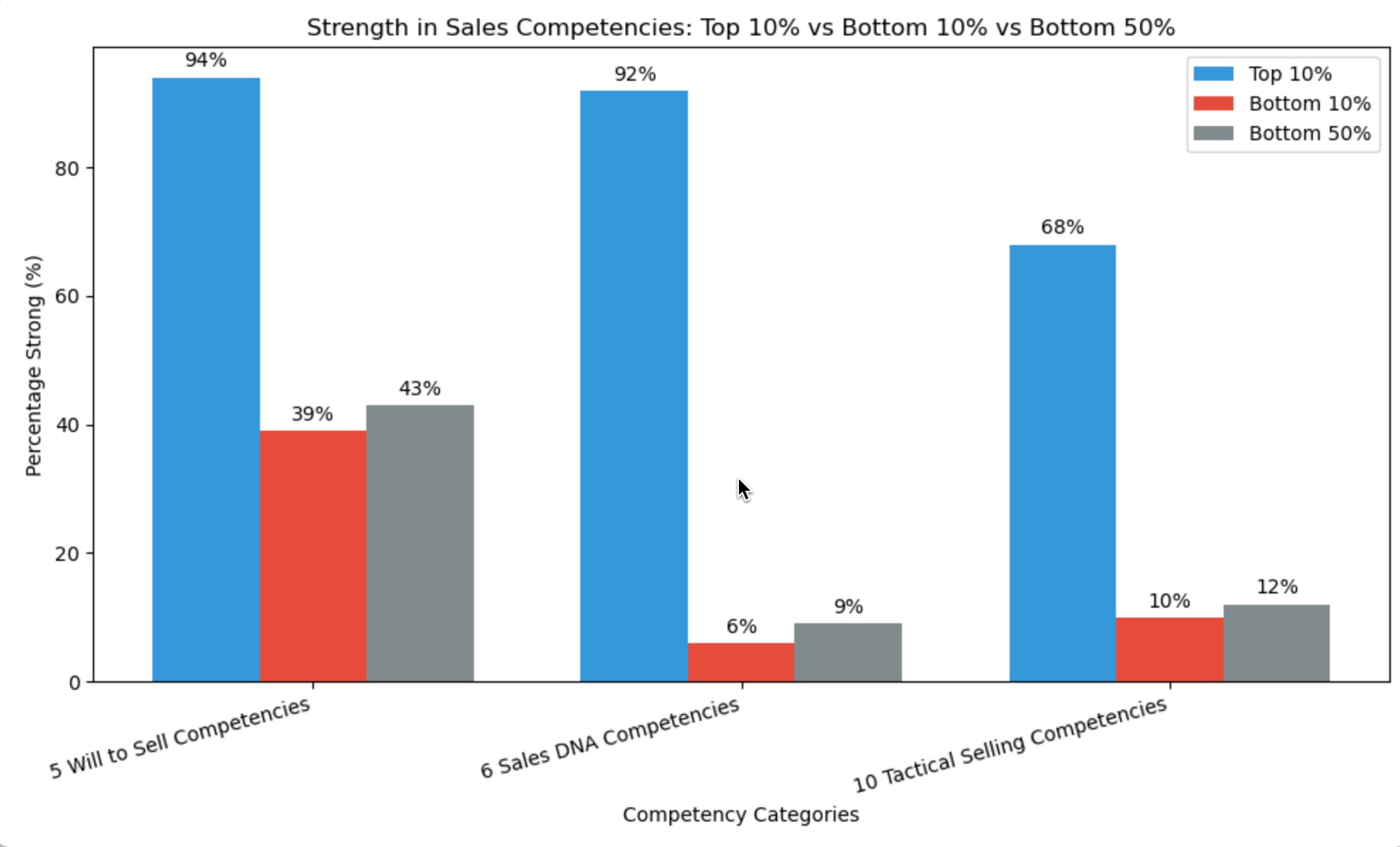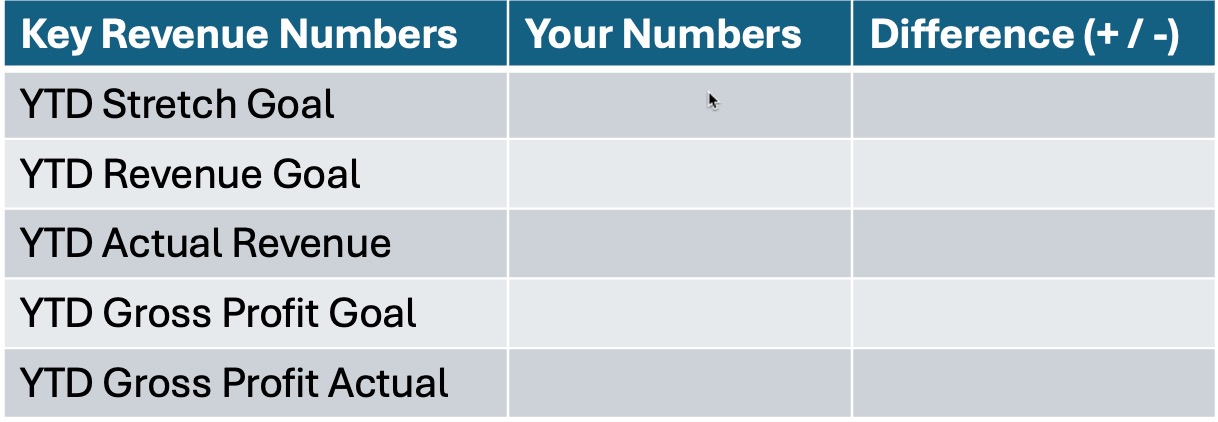- May 24, 2025
- Posted by: Dave Kurlan
- Category: Understanding the Sales Force

This is the most important article I have written in 2025 and it has a ton of eye-opening data, useful insights, and actionable next steps, so grab your favorite beverage, enjoy and please push through despite the longer than normal length of this article.
In 2017, 89% of the top salespeople did not need to be liked compared with 84% from the 2025 data, while 4% of the weakest salespeople did not need to be liked compared with 5% in the 2025 data. The best salespeople have become weaker in that competency and the weakest salespeople have become a bit stronger. I needed to know if that change is unique to this single competency or there were similar changes to all 21 Sales Core Competencies.
I conducted some in-depth research and then created the following table which shows 2017 and 2025 data, the percentage of salespeople who are strong in each competency, and a comparison of the strongest (top 10%) versus the weakest salespeople (bottom 10%).
The 2017 data is based on approximately 600,000 salespeople who were assessed by OMG between 2012 and 2017, while the 2025 data is based on approximately 32,000 OMG sales assessments from the first four months of 2025.
Comparing 2017 and 2025, the percentage of top salespeople that were strong overall dropped by approximately 2% while the percentage of salespeople that were weak remained about the same. However, when I reviewed each competency independently from the whole, I observed several significant changes.
There is a statistically significant increase in the percentage of salespeople who are strong in these 6 competencies:
- Outlook – how they feel about themselves, their job, who they work with and for, etc.
- Responsibility – taking responsibility for their results instead of rationalizing or making excuses
- Stays in the Moment – being present in their sales conversations and actively listening to their prospects
- Comfortable Discussing Money – their ability to easily have financial conversations with prospects
- Relationship Builder – their ability to build and maintain strong relationships
- Consultative Seller – their ability to ask good, tough, timely questions to uncover compelling reasons to buy
There are also statistically significant regressions in these 9 competencies:
- Doesn’t Need to be Liked – salespeople who don’t need to be liked are able to ask tough questions, push back and challenge their prospects
- Supportive Beliefs – the collection of beliefs that either support selling and sales outcomes, or sabotage them
- Supportive Buy Cycle – the way the salesperson makes major purchases supports ideal selling outcomes
- Hunting – willingness and effectiveness at prospecting for new business
- Reaches Decision Makers – ability to either start with the actual decision maker or work their way there.
- Qualifier – the ability to thoroughly qualify their opportunities.
- Closer – the ability to get the deal or account closed at closing time.
- Sales Process – the ability to follow and successfully execute the sales process.
- Sales Technology – the degree to which a salesperson has mastered CRM, LinkedIn and Video Conferencing
Alarmingly, the best salespeople regressed in more competencies than those in which they improved but all of the regressions can be explained.
COVID-19 lockdowns caused a sense of isolation and loneliness in many salespeople, even some of the great salespeople who I know, and for the first time, it caused them to seek friendship and approval from prospects. It’s why fewer top salespeople are strong in the Doesn’t Need to be Liked Competency.
Observation: The challenge of selling during and after COVID-19, along with the recession and inflation that followed, negatively affected the beliefs of many of the salespeople from the industries that were most affected. That is why fewer top salespeople have Supportive Beliefs as a strength.
Theory: The lockdowns also caused many, including top salespeople, to change the way they buy. For the first time, they began conducting online research, comparison shopped, and sought the lowest prices and shipping costs. This is why fewer top salespeople are strong in the Buy Cycle competency. That said, this competency is one of the most accurate competencies at predicting how salespeople will respond to objections over price, competition, relative cost, decision-making, and tire-kickers.
Facts: Many salespeople enthusiastically gave in and developed a false sense of security from email marketing (which didn’t work very well), and sending messages inside LinkedIn (which rarely works), while others have benefited from BDRs booking new meetings on their behalf. I wrote an article about why we should blow up the BDR role. It’s no wonder that fewer top salespeople have Hunting as a strength.
Facts: Decision Makers have become more difficult to reach and most salespeople take the path of least resistance. It makes sense that even top salespeople have regressed in the competency Reaches Decision Makers.
Facts: A growing number of stakeholders involved in buying and decision making have made it more difficult for salespeople to thoroughly qualify opportunities, causing top salespeople to also show regression in the Qualifying competency.
Theory: If top salespeople have regressed at reaching decision makers and qualifying, then it stands to reason that their ability to close business would regress too.
Fact: Considering their regression in those three critical competencies/sales process milestones, it would be impossible to have not regressed at executing the sales process.
Theory: The regression of top salespeople in the Sales Technology competency can be blamed on technology fatigue as well as sales management’s lack of governance and accountability.
These regressions have probably occurred at your company if you noticed smaller, weaker pipelines, delayed closings, stalled opportunities, and/or a lower win rate.
The data shows that despite the regressions, the top 10% of all salespeople are still a whopping 619% stronger than the bottom 10%!
I wanted to know if the difference would be less if we compared the top 10% to a larger sales population instead, such as the bottom 50%. My findings are displayed in the chart below.
 The chart show us that:
The chart show us that:
94% of the top salespeople are strong in Will to Sell (Desire, Commitment, Outlook, Motivation, Responsibility), compared to just 39% of the bottom 10%. They are 241% stronger! Expanding the data to include the bottom 50% moves the needle only 4 points to 43% strong. Salespeople with strong Will to Sell are more likely to do whatever it takes to succeed and the bottom 50% don’t have the same do what it takes mentality as the best salespeople.
92% of the top salespeople are strong in Sales DNA (Doesn’t Need to be Liked, Stays in the Moment, Supportive Beliefs, Supportive Buy Cycle, Comfortable Talking about Money, Rejection Proof) compared to just 6% of the bottom 10%. They are 153% stronger! Expanding the data to include the bottom 50% moves the needle 3 points to only 9% strong in Sales DNA. Sales DNA supports the execution of sales process, sales methodology, sales strategy and sales tactics. When Sales DNA is weak, it serves to sabotage rather than support.
68% of the top salespeople are strong in the ten Tactical Selling Competencies compared to only 10% of the bottom 10%. They are 68% stronger! Expanding the data to include the bottom 50% moves the needle 2 points to only 12%. The bottom 50% are nearly as pitiful at selling as the bottom 10%.
There are a few more interesting takeaways.
In the 10 Tactical Selling Competencies, the percentage of the bottom 10% that are strong is close to zero in each competency except Relationship Building and Presentation Approach. In other words, the bottoms attempt to make friends and pitch what they sell and that’s all they know how to do. 0% – that’s zero percent – of bottoms are strong at the Consultative Seller and Qualifier competencies, proving that while the bottoms don’t know how to sell, they might be just fine taking orders.
The largest difference between tops and bottoms can be seen in the Value Seller competency, where tops are an incredible 920% better than the bottoms.
So many executives don’t understand why most (anywhere from 57% to 82% depending on sources) salespeople don’t hit quota.
What’s not to understand?
Half of all salespeople suck and too many companies don’t do anything constructive to improve that. They resist terminating underperforming salespeople, and fail to provide quality, professional sales training and development to improve the capabilities of their salespeople (performers and non-performers).
Among a company’s financial data, there are five numbers relevant to sales growth potential that belong in this conversation. Insert your numbers below:
This is simple. If your actual revenue and/or gross profit are short of where you must be YTD, and/or short of where you would like to be YTD, the 21 Sales Core Competencies and the 20 Sales Management Core Competencies (not discussed in this article) hold the answers. While you can take a wild-ass guess as to the capabilities of each salesperson and sales manager in each competency, experience suggests that you would be wrong, not only in each competency, but also in the 250 or so sales-specific attributes that make up those competencies. You would be wrong because while you can observe their revenue, average sale, average margin, win rate, and pipeline, you don’t really know why (the competencies) they get those results.
Gaining this knowledge improves your sales team awareness and allows you to make better decisions. Use that knowledge to professionally train, develop, coach and/or replace salespeople. It will improve the sales team, sales culture, and results, while your salespeople gain the ability to crush both revenue and stretch goals. How do you feel about a realistic 33% increase in sales?
A useful, free tool can be accessed from this page where you can see some of the OMG data on the 21 Sales Core Competencies. You can sort by industry, see how your company compares, and more.
Image created by Grok3


